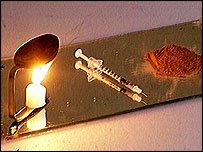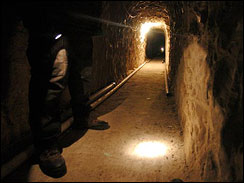The Oakland PressBy BOB GROSS
You probably don't know what salvia divinorum is. But there's a chance your Internet-savvy kids do. You're not alone in ignorance - many school administrators and police officials also know little to nothing about salvia, a hallucinogenic plant from southern Mexico related to cooking sage and a member of the mint family. Described by one person who has dabbled with the plant as an "intense" experience, salvia is not a controlled substance and is not illegal in many states, including Michigan.
It's also readily available over the Internet from cybershops that sell it for as little as $9.95 for an ounce of the dried leaves and that target young adults with color-coded packets and pop-up ads touting a "legal high."
And, yes, they do take credit cards.
"This is just another example of another concern we have with the Internet," said Farmington Hills Police Chief William Dwyer.
Dwyer, who headed the narcotics division of the Detroit Police Department before coming to Farmington Hills, had not heard of salvia. "There's no police force to monitor the Internet," he said. "It's just such a wide open system that there's no way to monitor everything that's offered over the Internet. ... "To deal with every single criminal act or enterprise, it's just overwhelming." Undersheriff Michael McCabe of the Oakland County Sheriff's Office also was not aware of salvia. "I checked with our narcotics enforcement team, and they are familiar with it," he said.
"It's not illegal at this point in time," he said. "It's one of these things that gets out on the Internet and kids read about it and they smoke it."
The way the Internet permeates society ‹ especially youth culture ‹ sometimes leaves law enforcement behind the curve regarding new trends in substance abuse.
"These things get out there, and you've got these bloggers out there who say, ŒJust Google it,' and they Google it, and there it is," said McCabe. "It can apply to just about anything."
In Oakland County, he said, narcotics officers have not run across salvia or had any contact with it, "but that doesn't mean it's not out there."
It's out there, said Ken Krygel, drug and alcohol recognition expert at Macomb County Community College's Criminal Justice Training Center in Fraser.
"Our wonderful Internet drives this stuff," he said. Becoming more popular
People who work with drug abusers, said Krygel, are concerned that "once this stuff gets ingrained into like a culture or a certain age group, if they do ban it or try to stop people from using it, it just makes it more exciting."
Tom Ghena, executive director of Maplegrove Center, a chemical dependency treatment center in West Bloomfield Township, said therapists at the center have encountered teens who have experimented with salvia.
"There is a limited exposure that we are seeing here," he said. "Some of the kids are talking about it. It is something that they may use in passing, but certainly not a primary substance at this point."
Carolyn Gibson, public information officer for the federal Drug Enforcement Agency's Detroit Field Division, said the agency knows about salvia.
"Although it's not a controlled substance, it definitely is a drug and a chemical of concern for the DEA and other law enforcement agencies," she said.
Like Dwyer, McCabe and Krygel, she pointed to the Internet as a conduit for information about hallucinogens and other drugs.
"The Internet obviously expands people's drug interests, as well as a lot of dealers are on the Internet," she said. "The Internet, I guess, is enabling the drug problem to grow at a faster rate."
Anecdotal evidence, however, seems to indicate that salvia is not a major player in the drug culture.
"Here in Detroit, I could not say we have seen a lot of it," she said. "I do know it is becoming a drug of choice, particularly among teens and people in their early 20s.
"A lot of sales are taking place in head shops and on the Internet."
Salespeople at two local head shops said they had heard of salvia - and in one case had carried it - but were not selling it now. A salesman at a third store would not speak on the record but was selling a gram of salvia extract, made by boiling the leaves in grain alcohol, for $40 - $42.40 with sales tax.
According to Krygel, "If you're 18 years old, it's quite available to you."
While salvia was originally sold as a leaf or an oil, it's now available as a powder, said Krygel.
"That's the new way of buying it," he said. "You either dust it on whatever type of cigarette you want ... and you roll it in your joint or whatever and you use it.
"And it's legal."
Is it safe?
While the DEA, perhaps predictably, has concerns about the health effects of salvia, bloggers and Web sites tout the herb as natural, legal, safe and nonaddictive.
"It's safe if you use it responsibly," said Daniel Siebert. "It's safe if it's used at appropriate doses in appropriate settings."
Siebert, a resident of Malibu, Calif., who maintains an educational Web site about salvia, claims there is no indication salvia has negative physiological effects.
"At doses people have tried, it is not known to have toxic effects," he said. "Physiologically speaking, it seems to me to be pretty safe."
There are concerns, however, that users could hurt themselves while in an altered state.
"It's like getting drunk," said Siebert. "Drinking is relatively safe as long as you don't get in a car and drive when you're drunk, or as long as you don't grab a gun when you're drunk.
"You don't want to do dangerous things when you're altered."
Dr. Frank McGeorge, chief of emergency medicine at William Beaumont Hospital in Royal Oak, said that while he's aware of salvia, he's yet to see anyone in his emergency room because of it.
That doesn't mean, however, that he considers it completely safe.
"As with all herbal or ethnic remedies, they will eventually find their way into the subculture of people looking for a new high," said McGeorge. "And as people begin to experiment with them more and more, we will begin to see the harmful effects, because people will, one, push the level of their doses, or two, increase the frequency of use.
"The number of bad effects can begin to go up."
Krygel said there's not been enough research to indicate what a downside might be.
"With kids, they feel nothing is going to hurt them," he said.
McGeorge pointed to GHB, also known as the date rape drug, use of which can result in death.
"This is another example of a simple easily available substance, like GHB used to be, that fell into the popular subculture or drug subcultures and became a problem that medical professionals and law enforcement offi cials had to catch up with," said McGeorge.
Siebert, who first tried salvia in 1989, said users enter a dreamlike state.
"When we're sleeping, most of us stay still in our beds and don't act on what we're seeing," he said.
Most "trips" are short, about 10 to 15 minutes, he said.
"Some people will move around - move around in an aimless way," said Siebert. "They don't seem aware of the fact that they're moving around.
"Some people will get up and amble across the room kind of aimlessly. They don't remember doing that. They will remember some kind of visionary scene they were experiencing."
He claims the nature of the drug precludes it from becoming popular or part of the "club" scene.
"It's kind of a strange inner journey," he said. "It doesn't make people feel good and stimulated.
"It's kind of a weird thing that's hard to handle."
Krygel said reaction varies from user to user.
Love it or hate it
"You either love or hate the stuff when you take it," he said. "If you're a first-time user of it, and you have a bad trip, you'll never touch the stuff again."
Sometimes, he said, users report the sensation of being in a room where the door closes - and they're afraid the door will never open.
"Other people that will use it, they will always see that opening or the way out," he said. "Those are the types of people that will use it numerous times."
Siebert said he's seen studies indicating that the substance in salvia that induces hallucinations, called salvinorin-A, actually reduces production of L-dopamine in the brain, a neurotransmitter associated with pleasure and desire.
Salvia is used by shamans of the Mazateca people in southern Mexico much as peyote is used by other native cultures - as a religious experience, as a way to experience a different spiritual plane.
"For them," said Siebert, "it's getting in touch with sacred deities and beings, going into the spirit world and contacting these beings."
He's concerned that some people who use it don't take it seriously.
"They think, ŒHow strong can it be? It's legal,' " he said. "It can definitely cause problems for people if they use it in a reckless way."
He advocates using salvia as a "meditative tool rather than as a roller-coaster ride that throws you around."
"Personally, I don't think teenagers should be taking it because most of them don't have the maturity and are taking it for the wrong reason.
"I think it makes sense that we don't sell alcohol to minors," he said, "and we shouldn't sell salvia to minors either."
McGeorge agrees that salvia is "not likely to produce the effects that most people are going to be looking for in a drug.
"On the other hand, that doesn't mean it's not going to be used," he said. "Some kids, teens, adults will do anything to escape parts of their lives.
"The issue involving mindaltering drugs in general has more to do with escaping the pressures of your life in society." What can parents do?
Siebert said parents need to talk to their kids honestly about hallucinogenic plants and drugs.
"Find out what their reasons are for trying it," he said.
"People have their own minds, and to tell them they can't do this, sometimes it doesn't work."
McGeorge said parents need to know what their children are doing. He used the choking game - children choking each other until they pass out in order to get a "brain rush" - as an example.
"That's something that you just talk to your kids and if you know what they're doing, you have an opportunity to intervene," he said.
"(But) do you need to talk to your kids about the choking game specifically or salvia divinorum specifically?" he asked. "The list is so long that you probably couldn't go over them specifi cally."
For McGeorge, the issue isn't salvia, but substance abuse.
"I wouldn't say this single specific agent is something you need to be aware of," he said. "What your kids are doing and what they're involved with is what you need to be aware of.
"For every one of these we know about, there are probably about 10 that we don't know of."
 after collapsing in her primary school class last Wednesday.
after collapsing in her primary school class last Wednesday. 






